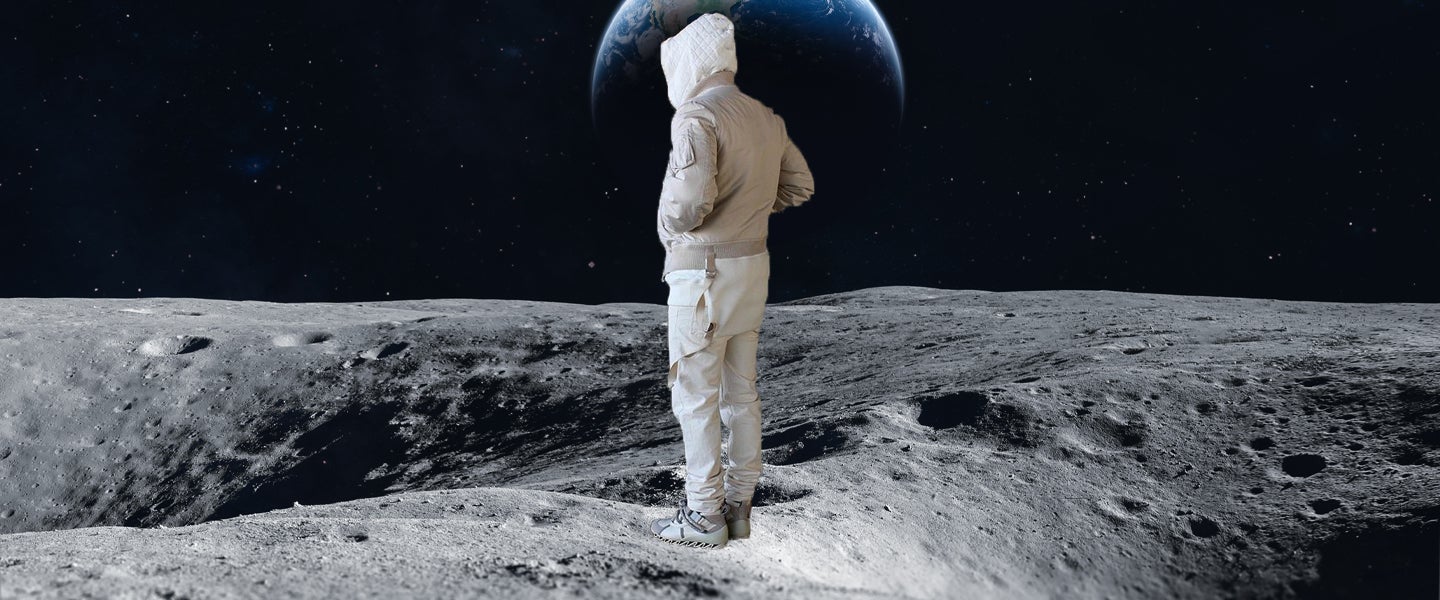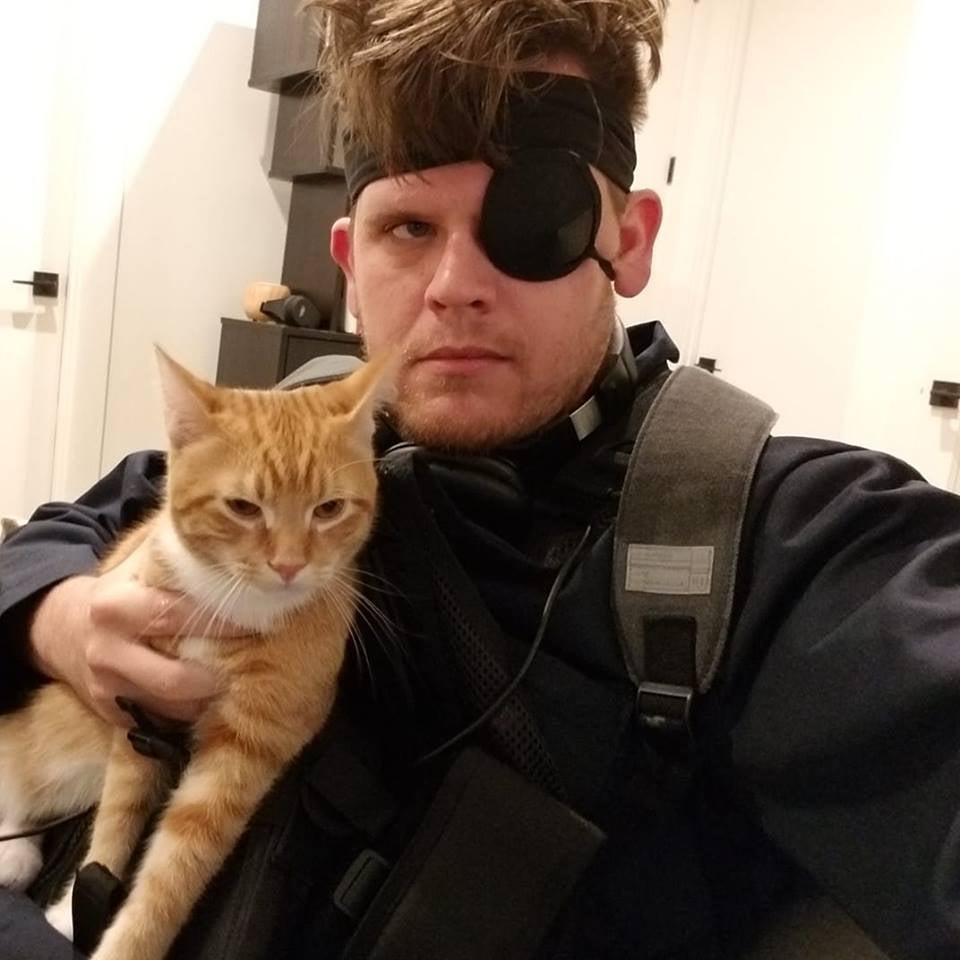Fifty years ago this month, Buzz Aldrin and Neil Armstrong took their first steps on the lunar surface. They were wearing chunky cosmic moonboots, billowy slate-white cargo pants, sepia-toned reflective visors and heavy space-age parkas, laden with pockets and patches, built to absorb the otherworldly harshness of the moon’s fingernail-thin atmosphere and barren dusty surface. Together, their spacesuits represented the best approximation of what humankind needed to survive on the moon. As such, they were utilitarian in nature, not September issue material, and any aesthetic pleasures were a distant consideration. Just ask Armstrong: It’s more important to breathe than to drip.
But Kannon Wrisley, a 27-year-old from South Carolina, disagrees with that premise. Astronauts may have suited up in those puffy alabaster shells hoping that they would stay free of solar radiation and esoteric deep-space diseases, but Wrisley adores the 1969 NASA aesthetic. So much so that he’s adapted it into his very own streetwear identity. As far as he’s concerned, spacesuits are for flexing. The term he and the like-minded people in the scene use is “lunarcore” — a tribute to the accidental fashionability that NASA discovered when it first sent men to space.
“It’s a general love of the whole clean, sterile future aesthetic,” he explains. “I’ve always been a fan of the laboratory or spaceship-of-the-future look as you see in the movies and games, so I feel lunarcore draws from that as well. At least those definitely inspire me, and are why I’m a big fan of it.”
Scroll through Wrisley’s Instagram, and you’ll get a good sense of what he’s after. “Off-whites, whites, oranges and blacks,” he says. Anything that evokes the palette of the early NASA materials that were jettisoned out of Cape Canaveral. Lately, he’s been into sheer aluminum textures like the goldenrod foil that coats every satellite in our airspace and glitters in a deeply satisfying way. “I like prints with lunar landscapes or planets,” he adds. “So I look for that, especially if it’s reflective.” When Wrisley pulls an ensemble together, he looks like a human born and raised on the moon — part of some distant future where spacesuits are modernized and streamlined to be extremely wearable in the Sea of Tranquility, where, ostensibly, the first off-world Supreme is minutes away from a drop.
If you scour the internet, you’ll find the term “lunarcore” being used as far back as 2014, and like a startling number of male fashion trends, it originated as a joke. Benji van Greene, a 21-year-old from the Netherlands, says he first discovered the aesthetic on the infamous 4Chan “fashion” section. That forum in particular is home to a variety of movements that straddle the line between meme and chic — think of arcane trends like normcore, health goth and Y2Kcore. “Hypebeast astronauts” was a natural accessory to the catalogue. Van Greene reminds me, too, that 4Chan has a longstanding tradition of bolting a suffix like “wave” or “core” onto nouns in order to create a fucked-up adjective; in that regard, “lunar” was just another casualty. “It starts as, ‘Look at these wackos doing whack shit,’” he says. “Then down the line, everyone realizes that lunarcore is the shit — but it always starts as a gag.”
Van Greene, like Wrisley, says he favors the lunarcore movement for its clean silhouette. On his Instagram, you can catch him in sherpa hoodies, milky-white industrial boots, napalm-bleached hair and foreboding waste-management trousers. There’s no store that specifically specializes in lunarcore in the way that Champion and Fila own athleisure, so van Greene defines the scene as a salvage project. And so, he shops around and picks and chooses a variety of individual items from a selection of different fashion brands in order to piecemeal his way to a spacesuit. “What lunarcore is doing is bringing [the moon] back to Earth,” he explains. “It’s making it wearable by taking brands, and pulling them together in an aesthetic.”
Van Greene notes that there’s been a space-age inspiration in fashion for decades, most explicitly in the 1960s, as the world was briefly subsumed into lunar mania. Back then, people truly believed that they needed to prepare their wardrobe for an imminent future amongst the stars. The tradition, however, is still very much alive today in any Target, where T-shirts and jackets emblazoned with the NASA logo are a constant presence. (Shoe brands also constantly collaborate with the Administration; just last year, for example, Vans released a line of Apollo-flavored shoes.)
As far as Wrisley is concerned though, the big-box retail moon gear belongs to a different genre than what he considers lunarcore. “Target-esque NASA inspired stuff is more geared toward casual wear that you can throw with an old pair of cargo shorts and some random shoes,” he says. “A lot of the pieces you see in lunarcore are one-off, custom or high-end pieces that are meant for a specific look and feel that you have to plan an outfit around.”
What that “specific look and feel” is will depend on each customer, but van Greene has a distinct fantasy in mind. To him, NASA is retro — emblematic of a brighter, happier earth on its pathway to a high-tech utopia; yet that’s not exactly what captures his imagination. Instead, his space style icon is a grizzled cyberpunk dockhand on a grimy spaceport, loading pallets into the belly of a long-haul intergalactic transport before its next trip.
More generally, there’s no joyousness in lunarcore’s spaceflight. Imagine traveling a million light years, only to find the same problems and pollution you have back home. “I’m trying to portray what I think will be a barren wasteland earth. I’m trying to build an outfit that fits that while still being streetwear,” says van Greene. “You can go cosplay [a video game], but that’s not the same.”
It’s interesting to compare van Greene’s perspective on lunarcore with all the cosmic trends that have come before it. NASA — and space travel in general — has always been an aspirational brand. Americans guzzled Tang because the Apollo missions made them believe in our collective potential. But while you can now plunk down a small fortune to be one of the few civilians to witness life in orbit, millennials aren’t buying it anymore. Today, it’s much easier to be pessimistic about the fate of humanity — and some of us are already dressing the part.

